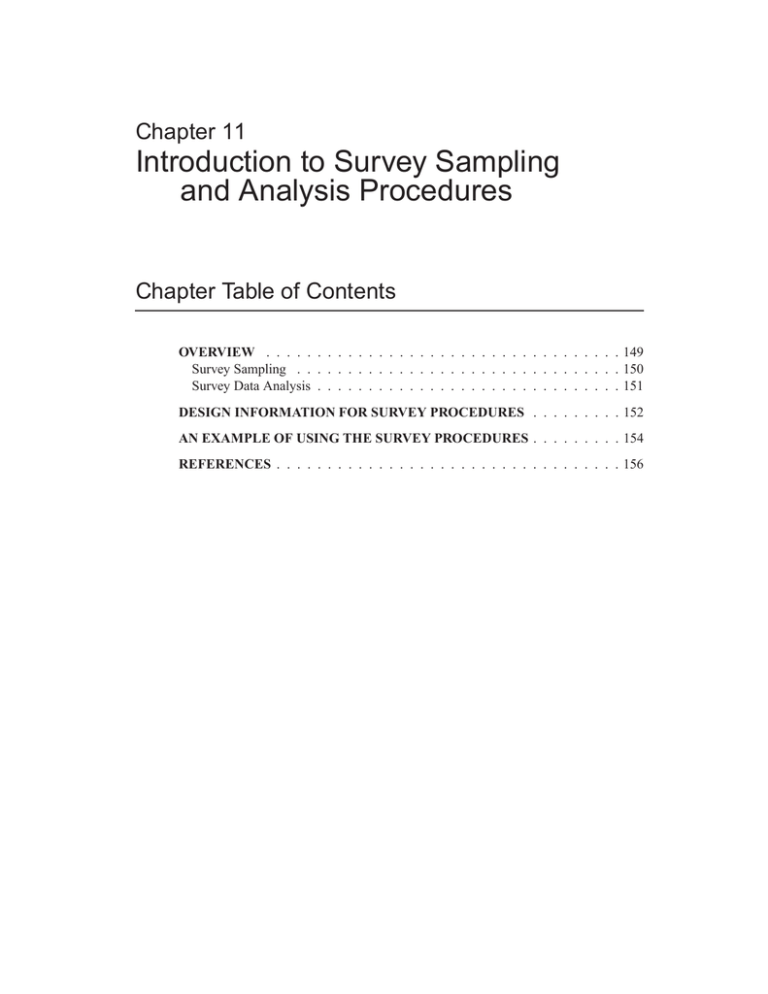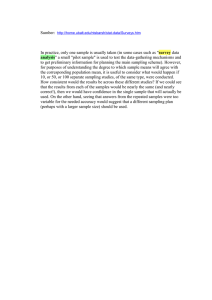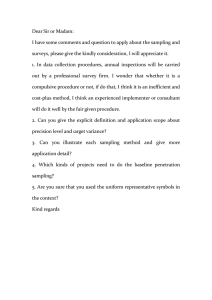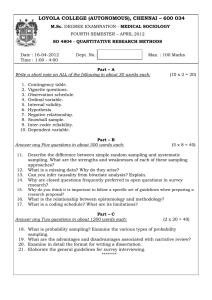
Chapter 11
Introduction to Survey Sampling
and Analysis Procedures
Chapter Table of Contents
OVERVIEW . . . . . . . . . . . . . . . . . . . . . . . . . . . . . . . . . . . 149
Survey Sampling . . . . . . . . . . . . . . . . . . . . . . . . . . . . . . . . 150
Survey Data Analysis . . . . . . . . . . . . . . . . . . . . . . . . . . . . . . 151
DESIGN INFORMATION FOR SURVEY PROCEDURES . . . . . . . . . 152
AN EXAMPLE OF USING THE SURVEY PROCEDURES . . . . . . . . . 154
REFERENCES . . . . . . . . . . . . . . . . . . . . . . . . . . . . . . . . . . 156
148 Chapter 11. Introduction to Survey Sampling and Analysis Procedures
SAS OnlineDoc: Version 8
Chapter 11
Introduction to Survey Sampling
and Analysis Procedures
Overview
This chapter introduces the SAS/STAT procedures for survey sampling and describes
how you can use these procedures to analyze survey data.
Researchers often use sample survey methodology to obtain information about a large
population by selecting and measuring a sample from that population. Due to variability among items, researchers apply scientific probability-based designs to select
the sample. This reduces the risk of a distorted view of the population and allows
statistically valid inferences to be made from the sample. Refer to Cochran (1977),
Kalton (1983), and Kish (1965) for more information on statistical sampling. You
can use the SURVEYSELECT procedure to select probability-based samples from a
study population.
Many SAS/STAT procedures, such as the MEANS and GLM procedures, can compute sample means and estimate regression relationships. However, in most of these
procedures, statistical inference is based on the assumption that the sample is drawn
from an infinite population by simple random sampling. If the sample is actually
selected from a finite population using a complex design, these procedures generally
do not calculate the estimates and their variances correctly. The SURVEYMEANS
and SURVEYREG procedures do properly analyze survey data, taking into account
the sample design. These procedures use the Taylor expansion method to estimate
sampling errors of estimators based on complex sample designs.
The following table briefly describes the sampling and analysis procedures in
SAS/STAT software.
SURVEYSELECT
Design Accommodated
stratification
clustering
replication
multistage sampling
unequal probabilities of selection
150 Chapter 11. Introduction to Survey Sampling and Analysis Procedures
Sampling Methods
simple random sampling
unrestricted random sampling (with replacement)
systematic
sequential
selection probability proportional to size (PPS)
with and without replacement
PPS systematic
PPS for two units per stratum
sequential PPS with minimum replacement
SURVEYMEANS
Design Accommodated
stratification
clustering
unequal weighting
Available Statistics
population total
population mean
proportion
standard error
confident limit
t test
SURVEYREG
Design Accommodated
stratification
clustering
unequal weighting
Available Analysis
fit linear regression model
regression coefficients
covariance matrix
significance tests
estimable functions
contrasts
The following sections contain brief descriptions of these procedures.
Survey Sampling
The SURVEYSELECT procedure provides a variety of methods for selecting
probability-based random samples. The procedure can select a simple random sample
or a sample according to a complex multistage sample design that includes stratification, clustering, and unequal probabilities of selection. With probability sampling,
each unit in the survey population has a known, positive probability of selection.
This property of probability sampling avoids selection bias and enables you to use
statistical theory to make valid inferences from the sample to the survey population.
SAS OnlineDoc: Version 8
Survey Data Analysis
151
PROC SURVEYSELECT provides methods for both equal probability sampling and
sampling with probability proportional to size (PPS). In PPS sampling, a unit’s selection probability is proportional to its size measure. PPS sampling is often used
in cluster sampling, where you select clusters (groups of sampling units) of varying
size in the first stage of selection. Available PPS methods include without replacement, with replacement, systematic, and sequential with minimum replacement. The
procedure can apply these methods for stratified and replicated sample designs. See
Chapter 63, “The SURVEYSELECT Procedure,” for more information.
Survey Data Analysis
The SURVEYMEANS and SURVEYREG procedures perform statistical analysis for
survey data. These analytical procedures take into account the design used to select
the sample. The sample design can be a complex sample design with stratification,
clustering, and unequal weighting.
You can use the SURVEYMEANS procedure to compute the following statistics:
population total estimate and its standard deviation and corresponding t test
population mean estimate and its standard error and corresponding t test
proportion estimate for a categorical variable and corresponding t test
(1 , )% confidence limits for the population total estimates, the population
mean estimates, and the proportion estimates
data summary information
PROC SURVEYREG fits linear models for survey data and computes regression coefficients and their variance-covariance matrix. The procedure also provides significance tests for the model effects and for any specified estimable linear functions of
the model parameters.
PROC SURVEYMEANS presently does not perform domain analysis (subgroup
analysis). However, note that you can produce a domain analysis with PROC SURVEYREG (see Example 62.7 on page 3269). This capability will be available in a
future release of the SURVEYMEANS procedure.
Variance Estimation
The SURVEYMEANS and SURVEYREG procedures use the Taylor expansion
method to estimate sampling errors of estimators based on complex sample designs.
This method obtains a linear approximation for the estimator and then uses the variance estimate for this approximation to estimate the variance of the estimate itself
(Woodruff 1971, Fuller 1975). When there are clusters, or primary sampling units
(PSUs), in the sample design, the procedures estimate the variance from the variation
among the PSUs. When the design is stratified, the procedures pool stratum variance
estimates to compute the overall variance estimate.
For a multistage sample design, the variance estimation method depends only on
the first stage of the sample design. Thus, the required input includes only firststage cluster (PSU) and first-stage stratum identification. You do not need to input
SAS OnlineDoc: Version 8
152 Chapter 11. Introduction to Survey Sampling and Analysis Procedures
design information about any additional stages of sampling. This variance estimation
method assumes that the first-stage sampling fraction is small or that the first-stage
sample is drawn with replacement, as it often is in practice.
For more information on variance estimation for sample survey data, refer to Lee,
Forthoffer, and Lorimor (1989), Cochran (1977), Kish (1965), Sarndal, Swenson,
and Wretman (1992), Wolter (1985), and Hansen, Hurwitz, and Madow (1953).
In addition to the traditional Taylor expansion method, other methods for variance estimation for survey data include balanced repeated replication and jackknife repeated
replication. These methods usually give similar, satisfactory results (Wolter 1985,
Sarndal, Swenson, and Wretman 1992); the SURVEYMEANS and SURVEYREG
procedures currently provide only the Taylor expansion method.
See Chapter 61, “The SURVEYMEANS Procedure,” and Chapter 62, “The SURVEYREG Procedure,” for complete details.
Design Information for Survey Procedures
Survey sampling is the process of selecting a probability-based sample from a finite
population according to a sample design. You then collect data from these selected
units and use them to estimate characteristics of the entire population.
A sample design encompasses the rules and operations by which you select sampling
units from the population and the computation of sample statistics, which are estimates of the population values of interest. The objective of your survey often determines appropriate sample designs and valid data collection methodology. A complex
sample design often includes stratification, clustering, multiple stages of selection,
and unequal weighting.
For more detailed information, refer to Cochran (1977), Kalton (1983), Kish (1965),
and Hansen, Hurwitz, and Madow (1953).
To select a sample with the SURVEYSELECT procedure and analyze your survey
data with the SURVEYMEANS and SURVEYREG procedures, you need to specify
sample design information to those procedures. This information includes design
strata, clusters, and sampling weights.
Population
Population refers to the target population or group of individuals of interest for study.
Often, the primary objective is to estimate certain characteristics of this population,
called population values. A sampling unit is an element or an individual in the target
population. A sample is a subset of the population that is selected for the study.
Before you use the survey procedures, you should have a well-defined target population, sampling units, and an appropriate sample design.
In order to select a sample according to your sample design, you need to have a
list of sampling units in the population. This is called a sampling frame. PROC
SURVEYSELECT selects a sample using this sampling frame.
SAS OnlineDoc: Version 8
Design Information for Survey Procedures
153
Stratification
Stratified sampling involves selecting samples independently within strata, which are
nonoverlapping subgroups of the survey population. Stratification controls the distribution of the sample size in the strata. It is widely used in practice to meet a variety
of survey objectives. For example, with stratification you can ensure adequate sample
sizes for subgroups of interest, including small subgroups, or you can use stratification to improve the precision of overall estimates. To improve precision, units within
strata should be as homogeneous as possible for the characteristics of interest.
Clustering
Cluster sampling involves selecting clusters, which are groups of sampling units. For
example, clusters may be schools, hospitals, or geographical areas, and sampling
units may be students, patients, or citizens. Cluster sampling can provide efficiency
in frame construction and other survey operations. However, it can also result in a
loss in precision of your estimates, compared to a nonclustered sample of the same
size. To minimize this effect, units within clusters should be as heterogeneous as
possible for the characteristics of interest.
Multistage Sampling
In multistage sampling, you select an initial or first-stage sample based on groups of
elements in the population, called primary sampling units or PSUs.
Then you create a second-stage sample by drawing a subsample from each selected
PSU in the first-stage sample. By repeating this operation, you can select a higherstage sample.
If you include all the elements from a selected primary sampling unit, then the twostage sampling is a cluster sampling.
Sampling Weights
Sampling weights, or survey weights, are positive values associated with each unit in
your sample. Ideally, the weight of a sampling unit should be the “frequency” that the
sampling unit represents in the target population. Therefore, the sum of the weights
over the sample should estimate the population size N . If you normalize the weights
such that the sum of the weights over the sample equals the population size N , then
the weighted sum of a characteristic y estimates the population total value Y .
Often, sampling weights are the reciprocals of the selection probabilities for the sampling units. When you use PROC SURVEYSELECT, the procedure generates the
sampling weight component for each stage of the design, and you can multiply these
sampling weight components to obtain the final sampling weights. Sometimes, sampling weights also include nonresponse adjustments, post-sampling stratification, or
regression adjustments using supplemental information.
When the sampling units have unequal weights, you must provide the weights to the
survey analysis procedures. If you do not specify sampling weights, the procedures
use equal weights in the analysis.
SAS OnlineDoc: Version 8
154 Chapter 11. Introduction to Survey Sampling and Analysis Procedures
Population Totals and Sampling Rates
The ratio of the sample size (the number of sampling units in the sample) n and the
population size (the total number of sampling units in the target population) N is
written as
n
f=
N
This ratio is called the sampling rate or the sampling fraction. If you select a sample without replacement, the extra efficiency compared to selecting a sample with
replacement can be measured by the finite population correction (fpc) factor, (1 , f ).
If your analysis should include a finite population correction factor, you can input
either the sampling rate or the population total. Otherwise, the procedures do not use
the fpc when computing variance estimates. For fairly small sampling fractions, it is
appropriate to ignore this correction. Refer to Cochran (1977) and Kish (1965).
As stated in the section “Variance Estimation” on page 151, for a multistage sample
design, the variance estimation method depends only on the first stage of the sample
design. Therefore, if you are specifying the sampling rate, you should input the firststage sampling rate, which is the ratio of the number of PSUs in the sample to the
total number of PSUs in the target population.
An Example of Using the Survey Procedures
This section demonstrates how you can use the survey procedures to select a
probability-based sample, compute descriptive statistics from the sample, perform
regression analysis, and make inferences about income and expenditures of a group
of households in North Carolina and South Carolina. The goals of the survey are to
estimate total income and total basic living expenses
investigate the linear relationship between income and living expenses
Sample Selection
To select a sample with PROC SURVEYSELECT, you input a SAS data set that
contains the sampling frame, or list of units from which the sample is to be selected.
You also specify the selection method, the desired sample size or sampling rate, and
other selection parameters.
In this example, the sample design is a stratified simple random sampling design, with
households as the sampling units. The sampling frame (the list of the group of the
households) is stratified by State and Region. Within strata, households are selected
by simple random sampling. Using this design, the following PROC SURVEYSELECT statements select a probability sample of households from the HHSample
data set.
SAS OnlineDoc: Version 8
An Example of Using the Survey Procedures
155
proc surveyselect data=HHSample out=Sample
method=srs n=(3, 5, 3, 6, 2);
strata State Region;
run;
The STRATA statement names the stratification variables State and Region. In
the PROC SURVEYSELECT statement, the DATA= option names the SAS data set
HHSample as the input data set (the sampling frame) from which to select the sample. The OUT= option stores the sample in the SAS data set named Sample. The
METHOD=SRS option specifies simple random sampling as the sample selection
method. The N= option specifies the stratum sample sizes.
The SURVEYSELECT procedure then selects a stratified random sample of households and produces the output data set Sample, which contains the selected households together with their selection probabilities and sampling weights. The data set
Sample also contains the sampling unit identification variable Id and the stratification variables State and Region from the data set HHSample.
Survey Data Analysis
You can use the SURVEYMEANS and SURVEYREG procedures to estimate population values and to perform regression analyses for survey data. The following
example briefly shows the capabilities of each procedure. See Chapter 61, “The SURVEYMEANS Procedure,” and Chapter 62, “The SURVEYREG Procedure,” for more
detailed information.
To estimate the total income and expenditure in the population from the sample, you
specify the input data set containing the sample, the statistics to be computed, the
variables to be analyzed, and any stratification variables. The statements to compute
the descriptive statistics are as follows:
proc surveymeans data=Sample sum clm;
var Income Expense;
strata State Region;
weight Weight;
run;
The PROC SURVEYMEANS statement invokes the procedure, specifies the input
data set, and requests estimates of population totals and their standard deviations for
the analysis variables (SUM), and confidence limits for the estimates (CLM).
The VAR statement specifies the two analysis variables, Income and Expense.
The STRATA statement identifies State and Region as the stratification variables
in the sample design. The WEIGHT statement specifies the sampling weight variable
Weight.
You can also use the SURVEYREG procedure to perform regression analysis for
sample survey data. Suppose that, in order to explore the relationship between the total income and the total basic living expenses of a household in the survey population,
you choose the following linear model to describe the relationship.
Expense = + Income + error
SAS OnlineDoc: Version 8
156 Chapter 11. Introduction to Survey Sampling and Analysis Procedures
The following statements fit this linear model.
proc surveyreg data=Sample;
strata State Region ;
model Expense = Income;
weight Weight;
run;
In the PROC SURVEYREG statement, the DATA= option specifies the input sample
survey data as Sample. The STRATA statement identifies the stratification variables
as State and Region . The MODEL statement specifies the model, with Expense
as the dependent variable and Income as the independent variable. The WEIGHT
statement specifies the sampling weight variable Weight.
References
Cochran, W. G. (1977), Sampling Techniques, Third Edition, New York: John Wiley
& Sons, Inc.
Fuller, W. A. (1975), “Regression Analysis for Sample Survey,” Sankhya
, 37 (3),
Series C, 117–132.
Hansen, M. H., Hurwitz, W. N., and Madow, W. G. (1953), Sample Survey Methods
and Theory, Volumes I and II, New York: John Wiley & Sons, Inc.
Kalton, G. (1983), Introduction to Survey Sampling, SAGE University Paper series
on Quantitative Applications in the Social Sciences, series no. 07-035, Beverly
Hills and London: SAGE Publications, Inc.
Kish, L. (1965), Survey Sampling, New York: John Wiley & Sons, Inc.
Lee, E. S., Forthoffer, R. N., and Lorimor, R. J. (1989), Analyzing Complex Survey
Data, Sage University Paper series on Quantitative Applications in the Social
Sciences, series no. 07-071, Beverly Hills and London: Sage Publications, Inc.
Sarndal, C.E., Swenson, B., and Wretman, J. (1992), Model Assisted Survey Sampling, New York: Springer-Verlag Inc.
Wolter, K. M. (1985), Introduction to Variance Estimation, New York: SpringerVerlag Inc.
Woodruff, R. S. (1971), “A Simple Method for Approximating the Variance of
a Complicated Estimate,” Journal of the American Statistical Association, 66,
411–414.
SAS OnlineDoc: Version 8
The correct bibliographic citation for this manual is as follows: SAS Institute Inc.,
SAS/STAT ® User’s Guide, Version 8, Cary, NC: SAS Institute Inc., 1999.
®
SAS/STAT User’s Guide, Version 8
Copyright © 1999 by SAS Institute Inc., Cary, NC, USA.
ISBN 1–58025–494–2
All rights reserved. Produced in the United States of America. No part of this publication
may be reproduced, stored in a retrieval system, or transmitted, in any form or by any
means, electronic, mechanical, photocopying, or otherwise, without the prior written
permission of the publisher, SAS Institute Inc.
U.S. Government Restricted Rights Notice. Use, duplication, or disclosure of the
software and related documentation by the U.S. government is subject to the Agreement
with SAS Institute and the restrictions set forth in FAR 52.227–19 Commercial Computer
Software-Restricted Rights (June 1987).
SAS Institute Inc., SAS Campus Drive, Cary, North Carolina 27513.
1st printing, October 1999
SAS® and all other SAS Institute Inc. product or service names are registered trademarks
or trademarks of SAS Institute Inc. in the USA and other countries.® indicates USA
registration.
Other brand and product names are registered trademarks or trademarks of their
respective companies.
The Institute is a private company devoted to the support and further development of its
software and related services.





